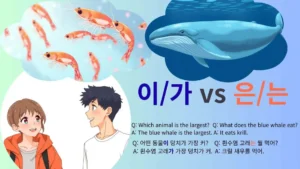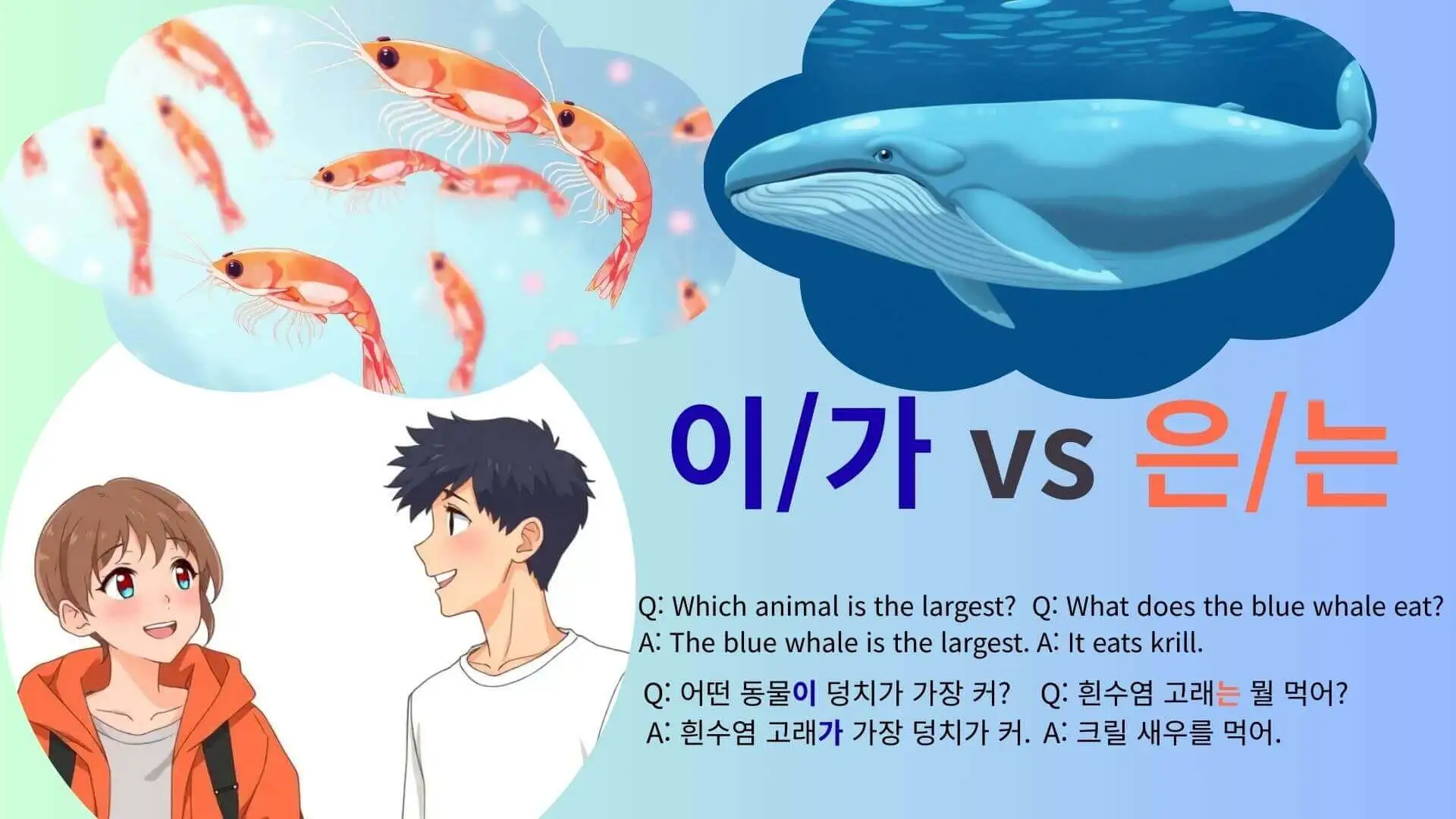Learn how to use Korean particles -이/가 and -은/는 correctly in everyday conversations. Understand new vs. given information, emphasis, contrasts, and friendly name forms for natural Korean speech.

1. Introduction — Why Korean Particles Are Tricky for Learners
For many learners coming from English and other Indo-European languages, Korean particles (조사) feel like a small but stubborn mystery. Unlike English, which relies heavily on word order and prepositions, Korean uses short post-positional markers attached to nouns to show grammatical roles and discourse functions. These markers are compact, frequent, and carry multiple layers of meaning — grammatical, pragmatic, and informational — all at once. That compactness is part of what makes them powerful, and also what makes them confusing.
In this series of posts we’ll focus on one of the most frequently misunderstood contrasts: the subject marker -이/가 versus the topic marker -은/는. On the surface they both appear to point to the same noun, but they steer the listener’s attention in different directions. Put simply: -이/가 often highlights the subject as new or focal information, while -은/는 frames the noun as a topic — what the sentence is about and foregrounds what is said about it.
Before we dive into examples and extended explanations, here are three practical reasons why understanding this distinction matters for learners:
- Natural-sounding speech and writing: Choosing the wrong particle can make a sentence sound awkward or change the nuance entirely. Native speakers use these markers intuitively to guide listeners through the flow of information.
- Comprehension of nuance: Even when the literal meaning stays the same, the particle can change the listener’s expectations — whether you are introducing new facts, making a contrast, or giving background information.
- Storytelling and discourse structure: In narratives and conversations, the shift between new and given information helps organize ideas. Particles are one of the primary tools Korean uses to signal those shifts.
In this post series we will not only explain the basic grammatical differences, but also explore two complementary perspectives that are useful for learners:
- Focus of attention: Who or what is the immediate target of the sentence’s attention?
- Information status: Is the noun being introduced for the first time (new information), or is it already known to the listener (given information)?
Each subsequent section will build on these ideas with varied, learner-friendly examples (everyday conversation, short narratives, Q&A patterns) and clear tips you can start using right away. I’ll also include comparisons to English constructions when they help, for example how a vs. the sometimes parallels the new/given contrast. That said, there is no perfect one-to-one mapping between Korean particles and English grammar — the best way to internalize these patterns is through exposure, guided practice, and paying attention to how native speakers shift emphasis.
Ready to begin? In the next section we’ll look at focus of attention: how the same event can be described with a different particle depending on whether you want to highlight the person involved or the information about them.
2. Focus of Attention — Shifting Emphasis with -이/가 and -은/는
One of the most practical ways to understand the difference between -이/가 and -은/는 is to think in terms of focus. Which part of the sentence is being highlighted? Korean speakers naturally use these markers to guide the listener’s attention, even when the core meaning of the sentence remains unchanged.
Consider the following pair of sentences:
- 민수가 어제 도서관에 갔습니다.
Minsoo subject-marker yesterday library went. - 민수는 어제 도서관에 갔습니다.
As for Minsoo, yesterday (he) went to the library.
At first glance, both sentences translate as “Minsoo went to the library yesterday.” However, the listener’s attention shifts depending on the particle:
- With -이/가: The emphasis is on who performed the action. If the listener was wondering
Who went to the library?
, this form directly answers that question. - With -은/는: The emphasis shifts to the fact or event of Minsoo going. This might be used when Minsoo has already been mentioned, and now the new piece of information is his trip to the library.
In this way, -이/가 can be thought of as spotlighting the actor, while -은/는 frames the statement as something being said about an already established subject.
Everyday Example
Imagine two friends talking:
A: 누가 도서관에 갔어요? B: 민수가 갔어요.
Here, -이/가 is natural because the question explicitly asks who went. The focus is on identifying the subject.
A: 민수는 어제 뭐 했어요? B: 도서관에 갔어요.
In this case, -은/는 is natural because the question already sets Minsoo as the topic. The listener’s curiosity is about what happened, not about who did it.
Why It Matters
Understanding focus helps learners avoid sentences that sound technically correct but slightly “off” to native ears. In many situations, either marker is grammatically possible — but the chosen particle changes where the spotlight shines. The distinction is subtle, yet it is this subtlety that makes Korean communication feel natural and precise.
In the next section, we will move from focus to a broader perspective: how -이/가 and -은/는 function when introducing new information versus describing something already known.
3. Introducing vs. Describing — How Particles Shape Information
Another way to grasp the difference between -이/가 and -은/는 is by asking: Am I introducing something new, or am I describing something that is already familiar? When a speaker brings up a person, animal, or object for the first time, the particle choice often signals whether the spotlight is on the subject itself or on the fact being presented about it.
First Introduction with -은/는
When you want to introduce a topic and immediately describe it, -은/는 is commonly used. This construction tells the listener: Here is what we are going to talk about, and here is some information about it.
기린은 가장 키가 큰 육상동물입니다.
As for giraffes, they are the tallest land animals.
In this sentence, the giraffe is presented as the topic, but the focus is actually on the descriptive information — that giraffes are the tallest among land animals.
Answering a Question with -이/가
Now compare it with a context where someone asks a specific question:
Q: Which animal is the tallest on land? A: 기린이 가장 키가 큰 육상동물입니다.
It is the giraffe that is the tallest land animal.
Here, -이/가 highlights the giraffe itself as the answer. The new and important piece of information is not the general fact about giraffes, but rather the identification of the tallest animal.
Describing Familiar Subjects
Once a subject has been introduced, subsequent sentences usually continue with -은/는 to provide further description. For example:
태민은 노래를 잘할 뿐만 아니라, 춤도 잘 춥니다.
As for Taemin, not only is he good at singing, but he is also good at dancing.
In this way, -은/는 helps maintain continuity, while -이/가 is reserved for moments when the subject itself becomes the crucial piece of information.
In the next section, we will expand on this idea by looking at how particles guide the flow of new versus given information in narratives and conversations.
4. New Information vs. Given Information — Guiding the Flow of Narratives
Another crucial perspective for understanding -이/가 and -은/는 is the distinction between new information and given information. In Korean, this distinction affects which particle you choose and how sentences are naturally sequenced in both conversation and storytelling.
New Information: Introducing Characters or Facts
When a noun appears for the first time in discourse, it is usually treated as new information. Korean speakers often use -이/가 to mark it, signaling to the listener: “Pay attention — this is something you haven’t heard yet.”
옛날 한 마을에 두 자매가 살고 있었습니다.
Long ago, in a village, two sisters lived together.
Here, “two sisters” are new to the listener. Marking them with -이/가 naturally highlights them as the subjects of the story’s opening.
Given Information: Describing Known Subjects
Once a character or object has been introduced, it becomes given information. Subsequent sentences typically use -은/는 to describe or elaborate on that subject without shifting the focus back to the noun itself.
언니는 동생에게 장난감을 주려고 했습니다.
The older sister intended to give her younger sister a toy.
In this case, “the older sister” has already been mentioned in the story. The particle -은/는 shifts the emphasis from introducing a new character to what she is doing — the action becomes the main focus.
Why It Matters
Understanding how new and given information interact with particle choice helps learners:
- Follow the flow of a story more naturally.
- Distinguish when to use -이/가 to spotlight a new subject versus -은/는 to maintain narrative continuity.
- Sound more native-like when constructing sentences in conversation.
In the next section, we will explore practical tips for learners, including questions to ask yourself when deciding which particle to use and comparisons to English grammar patterns.
5. Practical Tips for Learners — Choosing the Right Particle
By now, you’ve seen how -이/가 and -은/는 interact with focus and information status. Let’s turn these insights into practical strategies that learners can apply when speaking or writing in Korean.
Tip 1: Identify the Focus
Ask yourself: What is the main point of this sentence?
– If you want to highlight the subject itself as the new or important information, use -이/가. – If the subject is already known and you want to focus on what is being said about it, use -은/는.
Tip 2: Consider New vs. Given Information
– Introduce new characters, objects, or facts with -이/가. – Use -은/는 when providing additional information about something already mentioned in the conversation or story. This will help your sentences flow naturally and prevent confusion for your listener.
Tip 3: Use Questions to Guide Particle Choice
– Questions that ask who or what often call for -이/가 in the answer. – Questions that assume the subject already and ask what happened or what is true often call for -은/는. Examples:
Q: 누가 그림을 그렸어요?
A: 수민이가 그렸어요.
Who painted the picture? Sumin did.
Q: 수민은 오늘 뭐 했어요?
A: 그림을 그렸어요.
As for Sumin, she painted a picture today.
Additional Notes on Name + Particle Combinations
You might wonder why in the sentence 수민이가 그렸어요 there is a sequence of letters that looks like -이/가 after Sumin’s name. This happens because in Korean, a name takes an extra -이 before a particle when the speaker is addressing someone in a friendly or familiar way. It is common when an adult addresses a child or among close friends.
Similarly, in the second example:
Q: 수민은 오늘 뭐 했어요?
A: 그림을 그렸어요.
As for Sumin, she painted a picture today.
Actually, in a casual or friendly context, 수민이는 오늘 뭐 했어요? would sound more natural. Here’s why:
- For names ending in a consonant (받침) like 수민 or 수정, you attach -이 to the name before the particle: 수민이가, 수민이는.
- For names ending in a vowel like 영희 or 철수, no extra -이 is added because vowel + vowel sequences are awkward to pronounce.
So when you see 수민이가 or 수민이는, it is not a typo or double particle. It is a natural feature of Korean name + particle combinations to indicate friendly address while maintaining grammatical clarity.
Tip 4: Compare to English
While there is no exact equivalent in English, think of -이/가 like emphasizing “it is X who…” and -은/는 like using “as for X, …”. This analogy can help English speakers intuitively grasp the difference between subject-focus and topic-focus in Korean sentences.
Mastering these practical tips will allow learners to use particles more confidently and make their Korean sound natural. In the next section, we’ll look at how these rules apply to other particles and related structures.
6. Contrasts and Emphasis — How Particles Affect Meaning
Beyond focus and information status, Korean particles also serve to create contrasts and emphasize particular elements in a sentence. Choosing between -이/가 and -은/는 can subtly change the listener’s perception of what is important.
Using -은/는 for Contrast
The topic particle -은/는 is often used to set up a contrast with another subject or fact. By framing the noun as a topic, the speaker signals that there is more to compare or highlight.
민수는 사과를 좋아하지만, 지민은 바나나를 좋아합니다.
As for Minsoo, he likes apples, but as for Jimin, she likes bananas.
Here, -은/는 draws attention to the difference between Minsoo and Jimin. Without these particles, the contrast would be less explicit, and the sentence might feel less organized.
Using -이/가 for Emphasis
In contrast, -이/가 can be used to highlight the subject itself as the key piece of information, especially when answering a question or introducing new facts.
Q: Who solved the problem?
A: 지민이가 해결했어요.
It was Jimin who solved the problem.
By using -이/가, the speaker emphasizes Jimin as the one responsible. The focus is on identifying the actor, rather than providing additional commentary about a known topic.
Why This Matters
Recognizing how particles create contrasts and emphasize subjects helps learners:
- Make sentences more precise and natural.
- Convey subtle nuances in conversation.
- Understand native speakers’ intentions in dialogues and stories.
In the next section, we’ll explore how these particle distinctions appear in real-life conversation patterns, including questions, answers, and casual exchanges.
7. Real-Life Usage — Particles in Everyday Conversations
Understanding Korean particles in theory is helpful, but seeing them in real-life contexts makes the rules clearer. Native speakers naturally choose -이/가 or -은/는 depending on what they want to emphasize or contrast in daily conversation.
Questions and Answers
Particles often change depending on the type of question asked. When a question seeks to identify who or what performed an action, -이/가 is commonly used in the answer:
Q: 누가 숙제를 했어요?
A: 철수가 했어요.
Who did the homework? Cheolsu did.
Here, -이/가 highlights the subject “Cheolsu” as the new information. The particle signals that this is the critical piece of information the listener is looking for.
Describing Ongoing or Known Facts
Once the subject has been mentioned or the conversation topic is clear, -은/는 is used to provide additional information or commentary:
철수는 숙제를 끝내고 친구와 놀러 갔어요.
As for Cheolsu, he finished his homework and went out to play with a friend.
In this sentence, the focus is no longer on who Cheolsu is, but on what he did. Using -은/는 maintains continuity and keeps the narrative smooth.
Casual Conversation Tips
- Pay attention to whether you are introducing someone or talking about something already known.
- Use -이/가 to answer direct questions about a subject.
- Use -은/는 when continuing to describe a topic in an ongoing conversation.
Observing these patterns in real conversations will help learners internalize the particle usage, making speech sound more natural and native-like. In the final section, we will summarize the key points and offer guidance on practicing these patterns effectively.
8. Summary and Practical Guidance
Korean particles -이/가 and -은/는 are small but powerful tools that shape meaning, highlight focus, and guide the flow of information. By understanding how they work, learners can communicate more clearly and naturally.
Key Takeaways
- -이/가 is used to mark the subject when introducing new information or emphasizing who/what is performing an action.
- -은/는 is used to indicate the topic, describe known subjects, and highlight contrasts or additional information.
- New vs. given information helps determine which particle to choose in narratives and conversations.
- Particles play a role in real-life situations, including answering questions, providing descriptions, and maintaining smooth dialogue.
- When addressing someone by name, pay attention to friendly forms: -아 when simply calling someone, -이 before particles for names ending in consonants
(e.g., Sumin, Sujeong are names ending with a consonant, so -이 is added before particles: Sumin-i가, Sujeong-i는;
names ending with a vowel, like Cheolsu or Younghee, do not take -이).
When calling someone without a particle in a friendly way, consonant-ending names take -아 and vowel-ending names also take -야: Sumin-a, Sujeong-a; Younghee-ya, Cheolsu-ya.
Practical Tips for Learners
- Ask yourself whether the subject is new information or a known topic.
- Decide whether the focus is on the subject itself (-이/가) or on what is being said about it (-은/는).
- Observe native speakers in conversation to see natural usage patterns.
- Practice forming questions and answers using both particles to internalize their functions.
By keeping these principles in mind, learners can gradually develop a more intuitive sense of Korean particle usage, making their sentences sound natural, fluent, and contextually appropriate. With consistent practice, understanding the subtle distinctions between -이/가 and -은/는 becomes second nature.

